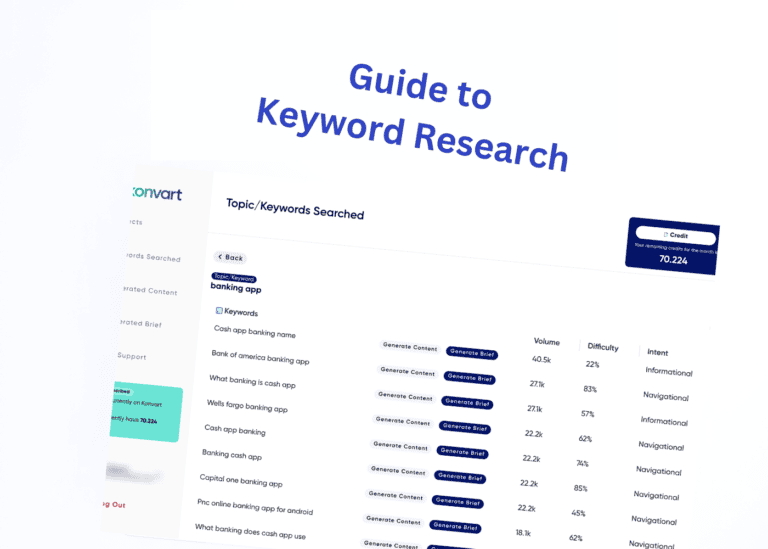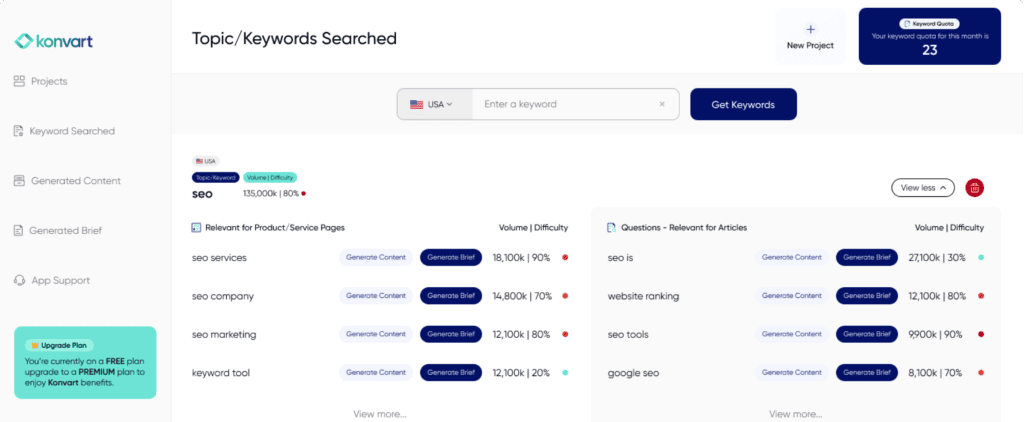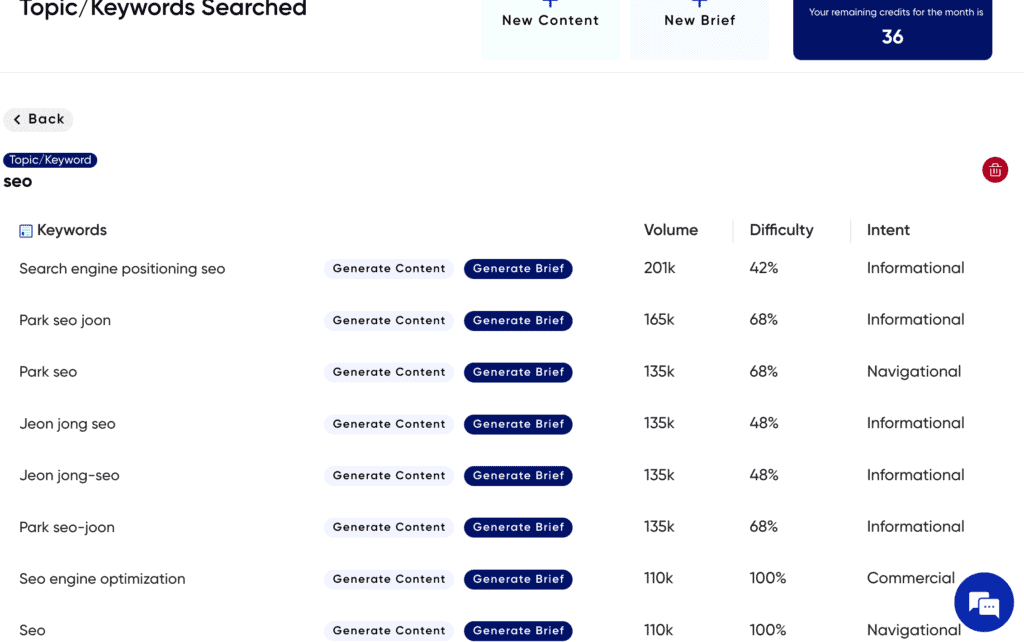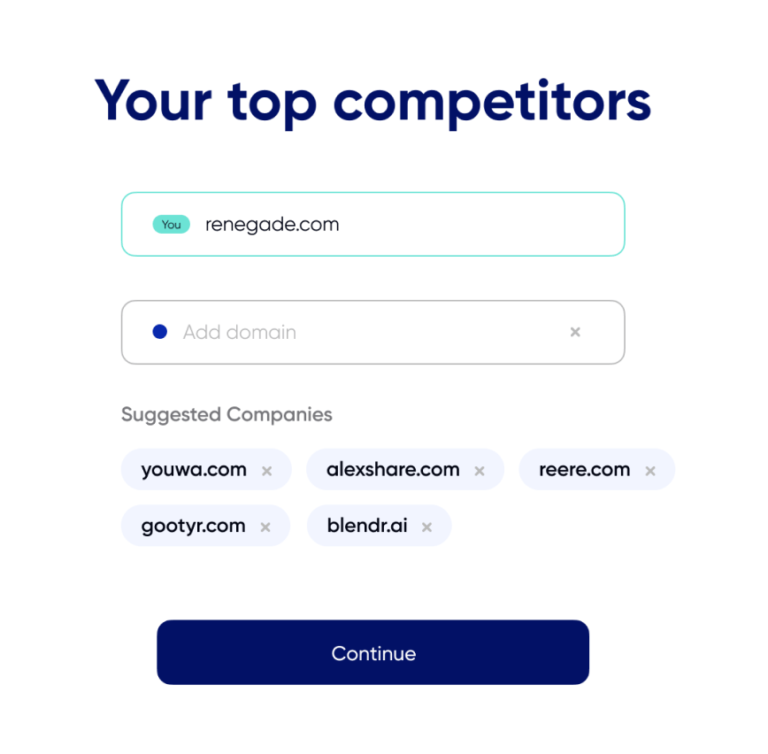Keyword research is a foundational practice in search engine optimization, guiding businesses and content creators to enhance their online visibility. It involves identifying popular words and phrases that people enter into search engines and optimizing web content accordingly.
Effective keyword research improves search rankings and helps understand market trends and consumer behavior, making it a critical element for any successful SEO strategy.
Why is Keyword Research Important for SEO?
Understanding the significance of keyword research in search engine optimization (SEO) is pivotal for any digital marketing strategy. This process enhances web content’s visibility and ensures that it reaches the right audience, which is fundamental for driving traffic and increasing engagement. Here are some of the benefits of SEO keyword research:
Aligning Content with User Intent
Keyword research is instrumental in aligning content with what users are actively searching for. By identifying popular and relevant terms within your target market, you can tailor your content to meet the current demands and queries of your audience. This alignment significantly boosts the likelihood of your content appearing in search results when potential customers are seeking information related to your products or services.
A study revealed that 61% of SEO marketers believe improving SEO and growing their organic presence is a top inbound marketing priority. This statistic underscores the importance of keyword research in achieving these goals.
Improving Search Engine Rankings
The strategic use of researched keywords can substantially improve your website’s rankings on search engines. Search engines aim to provide users with the most relevant results for their queries, and by incorporating well-researched keywords into your content, you signal to these algorithms that your content is a good match for specific searches. This relevance is rewarded with higher rankings, which can lead to increased visibility and more organic traffic.
Competitive Edge
Keyword research also offers insights into the strategies employed by competitors, which is invaluable for staying competitive in a crowded market. By understanding which keywords are driving traffic to competitors’ sites, you can identify gaps in their strategies or areas where they have a strong presence. Armed with this knowledge, you can craft strategies to compete directly with them or to target niche segments that may be underserved.
Cost-Effective Marketing
Investing time in keyword research can lead to more cost-effective marketing efforts. Targeting specific and relevant keywords to your niche reduces the risk of spending resources on broad, highly competitive keywords that may not convert as well. Focused keyword strategies allow for more efficient use of marketing budgets, ensuring that you attract not just more traffic but higher quality traffic that is more likely to engage with your brand.
Enhanced User Experience
Finally, keyword research helps improve the overall user experience on a website by enabling content creators to produce material that answers questions, solves problems, and provides value. When users find the content they need and have a positive interaction with your website, this not only increases the likelihood of conversions but also builds trust and credibility in your brand.
Each of these points illustrates why keyword research is not just an optional aspect of SEO but a foundational one. By understanding and implementing effective keyword strategies, businesses can enhance their online presence, attract a targeted audience, and achieve sustainable growth in an increasingly digital marketplace.
General Understanding of How to Find Keywords
Finding the right keywords is a pivotal step in crafting content that attracts and engages your target audience. This process involves several strategies that can help you identify keywords that are not only relevant but also competitive enough to improve your SEO performance.
Utilizing Keyword Research Tools
One of the most effective methods is to use keyword research tools such as Google Keyword Planner, Konvart, Ahrefs, or SEMrush. These platforms provide insights into search volumes, keyword difficulty, and related search terms that can help you gauge the popularity and competitiveness of potential keywords. For example, Konvart allows you to see how often certain words are searched and how difficult it might be to rank for that term.
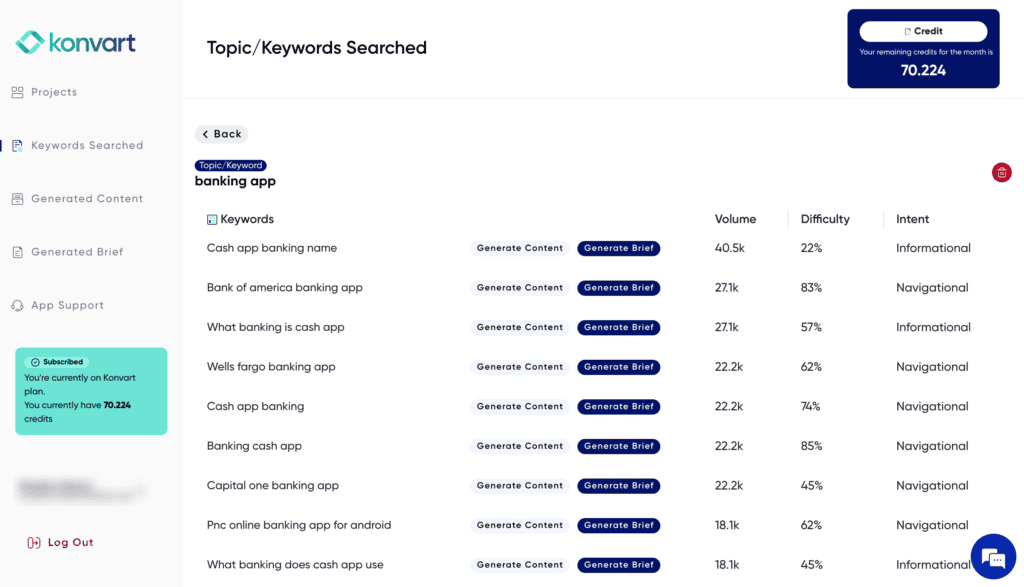
Analyzing Competitor Keywords
Another approach is to examine the keywords that your competitors are targeting. Tools like Moz’s Keyword Explorer can show you which keywords your competitors rank for and their corresponding ranking positions. With these, you can discover gaps in their strategies that might offer opportunities for you. This method helps in understanding what audiences in your niche are interested in and provides a benchmark against which to measure your keyword strategy.
Leveraging Social Media for Trending Topics
Social media platforms are treasure troves of information on current trends and consumer interests. Monitoring hashtags, conversations, and the popularity of certain posts can reveal what potential customers are talking about right now. This real-time data can guide you in selecting keywords that are immediately relevant and likely to draw traffic to your site.
Google’s Autocomplete and Related Searches
Simply typing a keyword into Google’s search bar and observing the autocomplete suggestions can provide ideas for keywords or phrases you might not have considered. Similarly, looking at the queries under “People also ask” or “Related searches” at the bottom of the search results page can expand your list of keywords.
Integrating these techniques into your keyword research strategy gives you a comprehensive view of the micro and macro trends influencing search behaviors. This holistic approach ensures that the keywords you select are well-positioned to effectively draw in and engage your target audience.
How to Choose Keywords
Choosing the right keywords is pivotal in optimizing your content for search engines and ensuring it reaches the right audience. This process involves several strategic considerations to maximize your blog’s visibility and engagement.
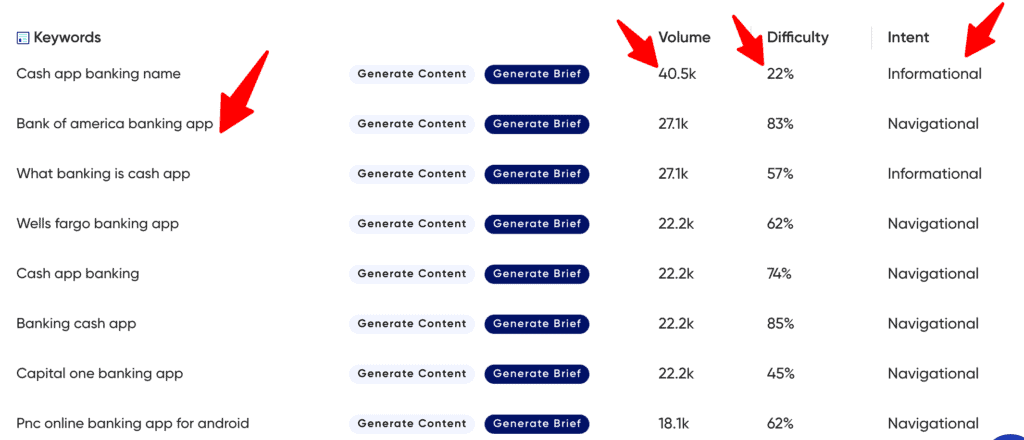
Understanding Search Intent
Search intent is the reason behind a user’s query on search engines. It is classified into four main types: informational, navigational, transactional, and commercial investigation. Selecting keywords that align with the intent of your target audience increases the relevance of your content, thereby enhancing user engagement and satisfaction. For instance, if you’re targeting individuals looking to buy a specific product, focusing on transactional keywords can drive conversions.
Relevance and Context
Keywords should be highly relevant to the content of your blog post. This improves SEO rankings and ensures that visitors find exactly what they are searching for, increasing the likelihood of them staying on your site longer. Context also plays a crucial role; the selected keywords should fit naturally within the content, maintaining readability and providing value to the reader.
Keyword Difficulty and Competition
Assessing keyword difficulty is essential for understanding how hard it would be to rank for specific keywords. Konvart offers insights into keyword difficulty scores. Lower scores often mean it is easier to rank for such keywords, especially for newer or less authoritative websites. Balancing between high-volume keywords and those with lower competition can yield better results in terms of visibility and traffic.
Search Volume Analysis
While high search volume keywords can attract more visitors, they often come with intense competition. On the other hand, long-tail keywords—more specific phrases with three or more words—are generally less competitive and can attract a more targeted audience. Utilizing a mix of both can be an effective strategy. Regularly updating your keyword strategy to adapt to trends and changes in search behavior is also beneficial.
The Keyword Research Process
1. Start with Broad Terms
Begin by listing out broad keywords related to your business or industry. These are typically one or two-word terms that broadly define your products or services. For instance, if you’re in the coffee business, start with terms like “coffee,” “espresso,” or “coffee beans.”
2. Expand with Long-Tail Keywords
Long-tail keywords are longer phrases that are more specific than broad terms and often less competitive. They are excellent for targeting niche demographics. For example, instead of just “coffee,” you might include “organic fair-trade coffee beans” or “best espresso for home brewing.” According to Search Demand Curve, long-tail keywords represent over 70% of all web searches, highlighting their importance in driving targeted traffic.
Furthermore, visitors are likely to use them when they’re closer to the point of purchase or when using voice search, and these keywords often have lower competition and higher conversion rates.
3. Utilize Keyword Research Tools
Leverage tools such as Google Keyword Planner, SEMrush, or Ahrefs to identify additional keywords. These tools provide data on search volume, competition level, and trends that can help refine your list with high-potential keywords.
4. Analyze Competitors
Look at the keywords your competitors are targeting. This can give you insights into what is working within your industry and help you spot opportunities they might be missing.
5. Consider Related/Secondary Keywords
Instead of focusing solely on individual keywords, consider related topics and terms that offer a broader coverage of the subject. This method ensures you’re not just attracting traffic looking for one-off information but also those interested in related content. For example, if you’re writing about “sustainable gardening,” include terms like “eco-friendly gardening tools” or “how to compost at home.”
6. Organize and Prioritize
Once you have a comprehensive list, organize the keywords by relevance and priority. Group them by similar themes or stages in the buyer’s journey. Prioritize them based on factors like search volume, competition, and strategic importance to your business goals.
Understand the Value of Any Keyword
In order to prioritse the keywords on your list, you should consider the value of the keywords.
The economic value of a keyword is determined by its potential to drive revenue. Tools like Google AdWords Keyword Planner can provide insights into the average cost per click (CPC), which reflects how much advertisers are willing to pay for a click on an ad triggered by a specific keyword. A high CPC indicates that the keyword has high economic value, suggesting that it can lead to profitable conversions when targeted correctly.
Another thing to look at is the search volume and competition to get a clear picture of a keyword’s demand and the difficulty level of ranking for it. Keywords with high search volumes and low competition are often more valuable as they offer the opportunity to attract more traffic with less competitive effort. However, it’s also important to consider long-tail keywords, which, despite lower search volumes, can be highly targeted and less competitive, making them valuable for niche markets.
A keyword’s value heavily depends on how well it aligns with user intent. Keywords must be relevant to the queries that potential customers are entering into search engines. This relevance ensures that the traffic driven by these keywords is qualified and more likely to engage with your content or convert into sales. Tools like SEMrush and Ahrefs provide valuable data on keyword variations and related questions that help in understanding user intent more deeply.
The SERP and Keyword Research
When conducting keyword research, analyzing the Search Engine Results Page (SERP) for a given keyword is a critical step. This analysis helps you understand the type of content that ranks well and the competition you face in securing a top position.
Understanding SERP Features
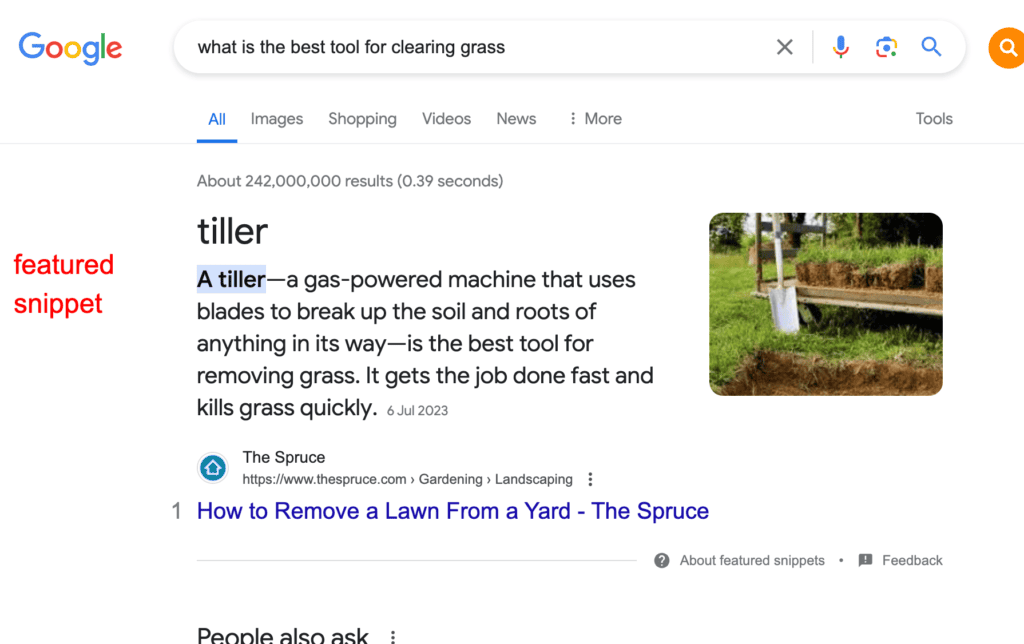
The SERP is more than just a list of links. Today’s search engine results pages feature a variety of elements, such as featured snippets, local packs, knowledge graphs, and video results. By examining these features for your target keyword, you can gauge what Google considers most relevant for that query. For instance, if a featured snippet appears, creating content that is concise and directly answers questions related to your keyword might increase your chances of obtaining that coveted spot.
Competitor Analysis
Evaluating who currently occupies the top positions in the SERP provides valuable insights into your competitors’ strategies. Look at their content format, length, and quality. Do they use images, videos, or infographics? Understanding these elements can guide your content creation to compete effectively. Additionally, checking their backlink profile using tools like Ahrefs or SEMrush could reveal opportunities to build similar or better backlinks.
Search Intent
Identifying the search intent behind your chosen keyword is crucial. The SERP can indicate whether users are looking for information, looking to make a purchase, or seeking a particular website. If most top results are product pages and you’re aiming to sell a product, this alignment is perfect. However, if top results are primarily informational blog posts and your intent is to sell, you might need to adjust your strategy or select different keywords.
Content Gaps and Opportunities
By analyzing the SERPs, you can spot gaps in existing content that you can exploit. Perhaps there’s an aspect of a topic that hasn’t been thoroughly covered by any top-ranking page. Producing content that fills this gap can not only meet user needs but also position you as an authority in your niche. Also, you may find gaps by checking People Also Ask for related questions that you can answer.
What to Look Out For When Performing Organic Keyword Analysis on Your Competitors
Analyzing your competitors’ organic keywords can significantly improve your SEO efforts. This process involves identifying which keywords are driving traffic to your competitors’ websites and understanding how these keywords are being used effectively in their content, meta descriptions, and backlinks.
Here are the steps to follow and what to look out for in this process:
- Identify Competitor Keywords: Begin by listing your main competitors, which can be found through simple market research or by using tools like SEMrush or Ahrefs. This initial step helps you gauge the competitive landscape and spot opportunities where your website could potentially rank.
- Analyze Keyword Effectiveness: Once you have a list of your competitors’ keywords, assess the effectiveness of each keyword. Check for the search volume and competition levels to determine which keywords are worth targeting in your SEO strategy.
- Understand Keyword Context: It’s not just about the keywords themselves but how they are used in context. Review your competitors’ top-ranking pages for these keywords. Look at how these keywords are integrated into titles, headers, and throughout the content. This can provide insights into content strategies that might resonate with your audience as well.
- Gap Analysis: Finally, perform a gap analysis to identify what your competitors are missing and how you can capitalize on these gaps in their keyword strategies. Maybe there are high-potential long-tail keywords they’ve overlooked, or perhaps there’s room for more in-depth content on certain topics.
As an additional tip (not related to keyword research), you can also examine the backlink profile of a competitor’s page that ranks well for a keyword you wish to target to identify potential linking opportunities. Check where their links are coming from and the quality of those links.
Why is Keyword Difficulty Important?
Keyword Difficulty is a metric that helps you assess how challenging it would be to rank for specific keywords on search engine results pages (SERPs). This tool gauges the competition level by analyzing various factors such as domain authority, page authority, and content quality of the existing ranking pages.
Functionality and Importance
The primary function of a Keyword Difficulty Checker is to provide a numerical score or rating that represents the level of difficulty to rank for a given keyword. This score helps marketers and content creators prioritize their efforts toward keywords that are realistically achievable based on their website’s current SEO strength. For instance, targeting a keyword with a high difficulty score might not be the best strategy for a new or less authoritative website.
Metrics Analyzed
Keyword Difficulty Checkers often consider several metrics to calculate their scores. These include the number of backlinks pointing to ranking pages, the quality of these backlinks, and the overall SEO optimization of competing pages. Some tools also incorporate the search volume of keywords, offering a balanced view between competitiveness and potential traffic gains.
Strategic Application
Using keyword difficulty metric involves more than just noting down difficulty scores. Integrating these insights into a broader keyword research strategy is required. For example, if a business finds that most desired keywords are highly competitive, it might explore long-tail variations, which typically have lower difficulty scores and less competition but can cumulatively drive significant traffic.
Advanced Keyword Research Tips
- Leverage Latent Semantic Indexing (LSI): LSI helps search engines understand the context surrounding keywords. Including semantically related terms in your content can improve its relevance and ranking.
- Explore Regional Keyword Variations: Different regions may use different terminologies or slang for the same concept. Tailoring your keyword strategy to include regional variations can capture a broader audience base.
- Monitor Keyword Trends: Google Trends is an invaluable tool for tracking the popularity of certain search terms over time. This can help you capitalize on rising trends or avoid diminishing ones.
How to Target Keywords
Effective keyword targeting is a linchpin in crafting content that attracts and engages the right audience. This process involves several strategic steps to ensure your keywords align perfectly with user intent and search engine algorithms.
Step 1: Write Quality Content
Your content must be of high quality and answers all the questions searchers have regarding the keyword. Furthermore, it must match the search intent.
Step 2: Place Keywords Right
Once the right keywords are identified, placing them strategically within your content enhances visibility. Key positions include the title, headers, opening paragraph, concluding paragraph, and naturally throughout the content where they fit contextually. However, avoid keyword stuffing, as it can negatively impact readability and SEO.
Beyond just adding keywords to text, consider other elements of SEO, such as URL structures and alt text for images. Each place you use a keyword is an opportunity to reinforce your topic relevance to search engines, helping you climb up the search results pages.
Step 3: Use Variations
Search engines are adept at understanding synonyms and related terms. Using semantic variations of your primary keyword enriches the content and avoids repetitiveness. This also improves user experience and strengthens the content’s SEO by aligning with natural language processing capabilities of modern search engines.
Step 4: Use Keywords in Meta Titles (and Descriptions)
Meta titles play a crucial role in SEO, but meta descriptions aren’t a ranking factor – nevertheless, a compelling meta description can help improve clickthrough rate. Your meta tag should include primary keywords and be compelling in order to draw users’ attention and encourage more clicks to your site.
Step 5: Publish and Track Performance
After implementing keywords, monitoring their performance is essential to understand their impact on SEO efforts. Analytics tools can show how particular keywords perform in terms of driving traffic and conversions. Regular reviews allow for adjustments in strategy, such as optimizing underperforming keywords or capitalizing on unexpected successful ones. Google Search Console is key here.
Regular monitoring allows you to catch any sudden drops in rankings, which could indicate issues like algorithm updates or increased competition.
When you track your keywords, it’s not just about noting their positions; it’s also crucial to analyze performance trends. For instance, if certain keywords consistently improve in ranking, it suggests that your SEO efforts are effective for those terms. Conversely, a decline in rankings for other keywords might prompt a review of your content or SEO tactics. This analysis helps in refining your keyword strategy, possibly by phasing out low-performing keywords or increasing focus on those bringing more traffic.
It’s also essential to keep your content fresh and updated. Search engines favor regularly updated content, so revisiting old posts to update statistics, add recent information, or refine your keywords as market trends change can be very beneficial.
FAQs
What is the best keyword research tool?
The best keyword research tool can vary depending on individual needs and preferences. Some popular options include Konvart, SEMrush, Ahrefs, and Moz Keyword Explorer. It’s important to choose a tool that provides accurate search volume data, keyword suggestions, and competition analysis to effectively optimize your SEO strategy.
How can keyword research benefit my website’s SEO strategy?
Keyword research is essential for improving your website’s SEO strategy as it helps you understand what terms and phrases your target audience is searching for. By identifying high-volume and low-competition keywords, you can optimize your website content to rank higher in search engine results pages, attract more organic traffic, and ultimately increase conversions.
What are the common mistakes to avoid in keyword research?
Common mistakes to avoid in keyword research include targeting broad keywords with high competition, neglecting long-tail keywords, ignoring user intent, and failing to update your keyword strategy regularly. It’s important to conduct thorough research, analyze data accurately, and stay up-to-date with industry trends to optimize your SEO strategy effectively.
How do you use keyword research to drive content creation strategies?
To use keyword research to drive content creation strategies, start by identifying relevant keywords that align with your target audience’s search intent. Create high-quality, informative content that incorporates these keywords naturally and provides value to your readers. Optimize your content for SEO by including relevant meta tags, headers, and internal links to improve visibility in search engine results.
What are the latest trends in keyword research for website design and SEO?
Some of the latest trends in keyword research for website design and SEO include voice search optimization, mobile-first indexing, featured snippets, and semantic search. Focus on creating conversational content that answers specific questions, optimizing for mobile devices, and providing structured data to enhance your website’s visibility in search results

